BREAST CARE
日本語はこちら
Breast Enlargement
Breast Enlargement
Breast Enlargement (Implants)
Silicone Implants Saline Implants
Fat Transfer for Breast Enlargement
Hyaluronic Acid Filler for Breast Enlargement
Breast Lift/Reduction
Gynecomastia Correction
Areola Reduction
Nipple Reduction
Inverted Nipple Correction
Breast Enlargement
Breast Enlargement (Implants)
Using breast implants is still the most reliable procedure in giving
the desired size and shape in performing breast enhancement. Two main types
are the silicone and saline implants, but nowadays, only silicone is mainly
used.
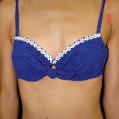
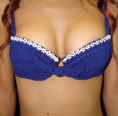
implant breast enlargement before/after
downtime: swelling&pain in 1to2 wks.,
if bruises, needs 2-3wks. to subside
Silicone Gel Implants
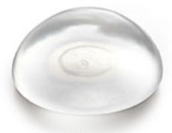 FDA-approved smooth-typed silicone gel implant is the brand of choice in our facility. It is filled
with safe cohesive silicone gel that sticks together to prevent leaking
when rupture or implant breakage occurs. Because of this feature, silicone
implant is sometimes called 'gummy-bear implant'. Implant sizes vary from
100 to 800 cc, around 200 to 300 cc is the estimated size to see 1-cup
bra size change in American bra sizes.
FDA-approved smooth-typed silicone gel implant is the brand of choice in our facility. It is filled
with safe cohesive silicone gel that sticks together to prevent leaking
when rupture or implant breakage occurs. Because of this feature, silicone
implant is sometimes called 'gummy-bear implant'. Implant sizes vary from
100 to 800 cc, around 200 to 300 cc is the estimated size to see 1-cup
bra size change in American bra sizes.
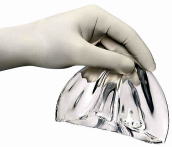
image of broken cohesive implant
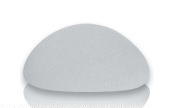 Rough-surfaced silicone implant called textured-typed silicone gel implant was produced to reduce the incidence of contracture(hardening)
of the capsule, the covering produced by the body when implant is inserted.
But there has been a serious issue concern about the textured type. 10
or more years later after implanting, textured-type implants might cause
a rare type of cancer called anaplastic large cell lymphoma(ALCL) in rare
chance of 1 in a milionth of operated cases. Textured implants production
may now be halted and this type might not be used anymore in medical settings.
Rough-surfaced silicone implant called textured-typed silicone gel implant was produced to reduce the incidence of contracture(hardening)
of the capsule, the covering produced by the body when implant is inserted.
But there has been a serious issue concern about the textured type. 10
or more years later after implanting, textured-type implants might cause
a rare type of cancer called anaplastic large cell lymphoma(ALCL) in rare
chance of 1 in a milionth of operated cases. Textured implants production
may now be halted and this type might not be used anymore in medical settings.
 Anatomical type is another popular implant type designed exclusively into anatomical breast
shape, but this type also is not the type of choice in our clinic. The
reason is that it might change its direction afterwards when it moves inside
the body where the capsule space is very spacious enough to rotate the
implant, which is not a problem in regular round type ones. Another concern
is that most of these anatomical ones are produced with textured coverings,
the reason we think that this might become extinct in the near future.
Anatomical type is another popular implant type designed exclusively into anatomical breast
shape, but this type also is not the type of choice in our clinic. The
reason is that it might change its direction afterwards when it moves inside
the body where the capsule space is very spacious enough to rotate the
implant, which is not a problem in regular round type ones. Another concern
is that most of these anatomical ones are produced with textured coverings,
the reason we think that this might become extinct in the near future.
Our clinic has been choosing smooth-typed inplants for over 10 years, since when the occurence of lymphoma was not an issue yet. The reason we do not select textured types is that they seem to produce more rippling(wrinkling) of breast skin, and sometimes their rough surfaces are more touchable from skin surface especially in individuals with originally smaller breast and thinner skin.
Breast enlargement surgery is performed under general anesthesia, with actual operation of 30 minutes, or 1 hour for the over all anesthetic process. After 1 night of bandage compression, it will be changed to a band compression beginning the next day until a week or a few weeks later. Stitch removal of wounds is done 1 to 2 weeks later.
Postoperative swelling is observed 1 to 2 weeks, and if bruises are noticeable, it might take until around 3 weeks. Inserting implants under the pectoral muscle causes more pain that lasts for 1 to 2 weeks. Unexpected side effects maybe noticed, such as bleeding and infection, so refraining from active movements and wetting of the wounds for 1 week postsurgically is a must advice.
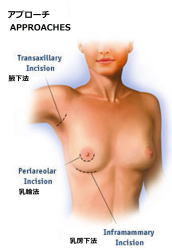 Approaches of implant insertion are made at armpits, areola, or submammary
folds, but areola procedure might sometimes show noticeable scar redness
or keloid, so usually we encourage patients to select submammary folds
or armpit approaches.
Approaches of implant insertion are made at armpits, areola, or submammary
folds, but areola procedure might sometimes show noticeable scar redness
or keloid, so usually we encourage patients to select submammary folds
or armpit approaches.
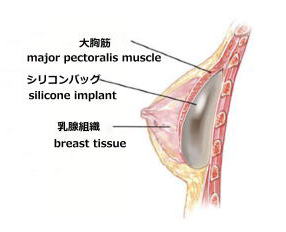
Implants are placed in submuscular layer most of the time because it is assumed to be the most reliable level to insert implants.
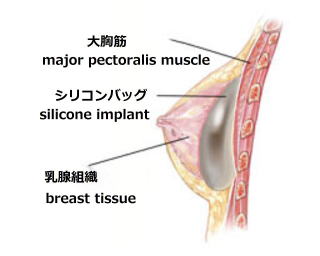
Subglandular(over muscle) placement is shallow enough to make implant contour or rims look so noticeable from breast skin years later, the main reason why it is not the first layer choice. But in cases with rich breast fat and skin tissues to cover the implants, to correct sagginess of loose breast skin, using 'dual plane technique' (submuscular insertion in upper breast area and subglandular in lower side) is also an option. But with thinner skin, this might not be able to hold implants after several years.
Subfascial insertion is another method suggestion which imply placement in between muscle surface and its fascia(muscle membrane) but this is not realistic enough since pectoral muscle fascia is not that thick to differentiate this technique from subglandular placement.
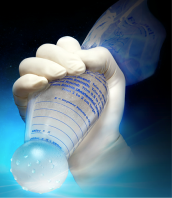 Keller Funnel is a remarkable creation of a plastic-made funnel to secure insertion
of an implant through a smaller incision without unnecessary touching of
the skin and instruments used in surgical setting, avoiding incidence of
unwanted contamination of the implant and its space.
Keller Funnel is a remarkable creation of a plastic-made funnel to secure insertion
of an implant through a smaller incision without unnecessary touching of
the skin and instruments used in surgical setting, avoiding incidence of
unwanted contamination of the implant and its space.
The rough criteria of implant size and its outcome are the following:


180cc bef/aft
downtime: swelling&pain in 1to2 wks.,
if bruises, needs 2-3wks. to subside


300㏄ bef/aft
downtime: swelling&pain in 1to2 wks.,
if bruises, needs 2-3wks. to subside


400㏄ bef/aft
downtime: swelling&pain in 1to2 wks.,
if bruises, needs 2-3wks. to subside
Saline-filled Implant


implant breast enlargement before/after
downtime: swelling&pain in 1to2 wks.,
if bruises, needs 2-3wks. to subside
Silicone Gel Implants
 FDA-approved smooth-typed silicone gel implant is the brand of choice in our facility. It is filled
with safe cohesive silicone gel that sticks together to prevent leaking
when rupture or implant breakage occurs. Because of this feature, silicone
implant is sometimes called 'gummy-bear implant'. Implant sizes vary from
100 to 800 cc, around 200 to 300 cc is the estimated size to see 1-cup
bra size change in American bra sizes.
FDA-approved smooth-typed silicone gel implant is the brand of choice in our facility. It is filled
with safe cohesive silicone gel that sticks together to prevent leaking
when rupture or implant breakage occurs. Because of this feature, silicone
implant is sometimes called 'gummy-bear implant'. Implant sizes vary from
100 to 800 cc, around 200 to 300 cc is the estimated size to see 1-cup
bra size change in American bra sizes.image of broken cohesive implant
 Anatomical type is another popular implant type designed exclusively into anatomical breast
shape, but this type also is not the type of choice in our clinic. The
reason is that it might change its direction afterwards when it moves inside
the body where the capsule space is very spacious enough to rotate the
implant, which is not a problem in regular round type ones. Another concern
is that most of these anatomical ones are produced with textured coverings,
the reason we think that this might become extinct in the near future.
Anatomical type is another popular implant type designed exclusively into anatomical breast
shape, but this type also is not the type of choice in our clinic. The
reason is that it might change its direction afterwards when it moves inside
the body where the capsule space is very spacious enough to rotate the
implant, which is not a problem in regular round type ones. Another concern
is that most of these anatomical ones are produced with textured coverings,
the reason we think that this might become extinct in the near future.Our clinic has been choosing smooth-typed inplants for over 10 years, since when the occurence of lymphoma was not an issue yet. The reason we do not select textured types is that they seem to produce more rippling(wrinkling) of breast skin, and sometimes their rough surfaces are more touchable from skin surface especially in individuals with originally smaller breast and thinner skin.
Breast enlargement surgery is performed under general anesthesia, with actual operation of 30 minutes, or 1 hour for the over all anesthetic process. After 1 night of bandage compression, it will be changed to a band compression beginning the next day until a week or a few weeks later. Stitch removal of wounds is done 1 to 2 weeks later.
Postoperative swelling is observed 1 to 2 weeks, and if bruises are noticeable, it might take until around 3 weeks. Inserting implants under the pectoral muscle causes more pain that lasts for 1 to 2 weeks. Unexpected side effects maybe noticed, such as bleeding and infection, so refraining from active movements and wetting of the wounds for 1 week postsurgically is a must advice.
 Approaches of implant insertion are made at armpits, areola, or submammary
folds, but areola procedure might sometimes show noticeable scar redness
or keloid, so usually we encourage patients to select submammary folds
or armpit approaches.
Approaches of implant insertion are made at armpits, areola, or submammary
folds, but areola procedure might sometimes show noticeable scar redness
or keloid, so usually we encourage patients to select submammary folds
or armpit approaches.
Implants are placed in submuscular layer most of the time because it is assumed to be the most reliable level to insert implants.

Subglandular(over muscle) placement is shallow enough to make implant contour or rims look so noticeable from breast skin years later, the main reason why it is not the first layer choice. But in cases with rich breast fat and skin tissues to cover the implants, to correct sagginess of loose breast skin, using 'dual plane technique' (submuscular insertion in upper breast area and subglandular in lower side) is also an option. But with thinner skin, this might not be able to hold implants after several years.
Subfascial insertion is another method suggestion which imply placement in between muscle surface and its fascia(muscle membrane) but this is not realistic enough since pectoral muscle fascia is not that thick to differentiate this technique from subglandular placement.
 Keller Funnel is a remarkable creation of a plastic-made funnel to secure insertion
of an implant through a smaller incision without unnecessary touching of
the skin and instruments used in surgical setting, avoiding incidence of
unwanted contamination of the implant and its space.
Keller Funnel is a remarkable creation of a plastic-made funnel to secure insertion
of an implant through a smaller incision without unnecessary touching of
the skin and instruments used in surgical setting, avoiding incidence of
unwanted contamination of the implant and its space.The rough criteria of implant size and its outcome are the following:


180cc bef/aft
downtime: swelling&pain in 1to2 wks.,
if bruises, needs 2-3wks. to subside


300㏄ bef/aft
downtime: swelling&pain in 1to2 wks.,
if bruises, needs 2-3wks. to subside


400㏄ bef/aft
downtime: swelling&pain in 1to2 wks.,
if bruises, needs 2-3wks. to subside
Saline-filled Implant

Saline-filled implant is an alternative for those who were not comfortable
using silicone ones. Procedures with this implant has become less since
the advent of the cohesive silicone gel, but recently, because of the issues
caused by silicone implants, saline ones are reviving their popularity
as well as fat transfer procedure to the breast.
Saline type is a safe option in case of rupture or breakage of implants but has higher rate of rupture incidence. However, replacement of newer saline implant is much easier and rather painless because of the same space can be used for insertion.
Saline-filled implant procedures must be done also using smooth-surface type to prevent rare occurence of malignant lymphoma.
The size of the approach wound for saline implants is much smaller than the one done for silicone type. Other operating and healing process are mostly the same with both implant types.
General anesthesia fee included
Saline type is a safe option in case of rupture or breakage of implants but has higher rate of rupture incidence. However, replacement of newer saline implant is much easier and rather painless because of the same space can be used for insertion.
Saline-filled implant procedures must be done also using smooth-surface type to prevent rare occurence of malignant lymphoma.
The size of the approach wound for saline implants is much smaller than the one done for silicone type. Other operating and healing process are mostly the same with both implant types.
Pricing
| without tax | with tax | ||
| Silicone Implants | Mentor's MemoryGel smoothtype up to 400cc | \850000 | \935000 |
| above 400cc | \900000 | \990000 | |
| Motiva's SilkSurface type up to 400cc | \600000 | \660000 | |
| above 400cc | \650000 | \715000 | |
| Saline Implants | Mentor's smooth type up to 400cc | \700000 | \770000 |
| above 400cc | \750000 | \825000 |
Fat Transfer for Breast Enlargement
Fat Transfer or Grafting was introduced to the world over a century ago,
but has only been practised seriously after the 2000s. Improvement in skills
and diligent studies have made this possible, however, there are still
some issues that have to be dealt with.
While fat grafting has many advantages, a list of disadvantages also does exist. Let's see first some of its ADVANTAGES:
・not artificial, self-derived autologous fats are safe
・more natural in shape and touch
・permanently remain in the tissue
・liposuction can be performed together
There might be some more, but these 4 are the main factors in the list.
Next are the DISADVANTAGES:
・most injected fats are resorbed, survival rate as bad as 20% up to 50%
・need treatments to achieve desired volume
・every session needs liposuction procedure
・non-surviving dead fat mass may turn into calcification or infection if not resorbed
About same number of cons as pros is the reality of this method, however, tactics have been developed to cope with these issues. Firstly, injected fats must be rich in fat stem cells(adipose stem cells ASC). Harvested fats is purified to highten ASC's density inside the graft, anticipating stem cells to grow and multiply into mature fat cells inorder to compensate for the resorbed portion of the graft.
Then, actual injection must be done in scattering manner by injecting fats in smaller strips along a layer and the same way at the other levels of the subcutis tissues, fat layers, and muscles, if necessary, to avoid creating a bulk.
Tissue layer condition also affects survival rate of the fats. Specifically, loose spacious layers embrace more of the graft than the dense and firm ones. Body parts with loose layers and saggy excessive skin that has more room usually adopt well to the injected fats about 2 or 3 times of its desired capacity, which is necessary to gain the desired goal. Injecting further more than these might cause low survival rate and undesirable side effects. Only body parts that have extra room for fats can tolerate the adequate enormous graft volume.
Fat graft is purified by the following process:
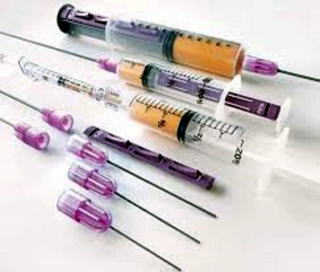
Liposuction or Mini Lipo by Syringe Method is used for harvesting fats.

Then syringes are centrifuged.
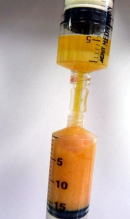
Impurities are separated from purified fats.
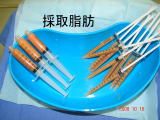
Directly inject fats or subdivide them to smaller syringes.
Breast fat transfer is a method that requires certain amount of fats which are usually harvested with the full tummy or thigh liposuction, not mini lipo.

breast fat transfer before/after
downtime: suctioned area swells, get sore, & bruise for 1to2 wks., breast part is puffy, tender, & sometimes bruise a bit for days
Volume of graft transfered is around 200cc on a side, 400cc on both sides. Of course, there might be exemption, but for regular body sizes, around 400cc is a safe amount for breast fat transfer. Fat survival rate really depends on condition of the breast tissue and skin. Loose tissue and excess skin that have plenty of room for fats can see better survival of graft while tighter breast might absorb most of the injected fats.
More than 600cc transfer is often peformed at other facilities, but more is not mostly better. This makes the breast tighter leading to a surrounding where fat graft won't survive that much and sometimes might show unnatural touch from calcification, and , for the worst, infection might occur.
Survival rate of the graft certainly differs in every individual, speaking from long experience, from 20 up to 50%. In American bra sizes, 200cc is a 1-cup upgrade. So 200cc of fats might turn out to be half-cup bigger. More treatments are needed if bigger size is desired. Surviving fats remain permanently.


breast hyaluronic acid injection before/after
downtime: breast part turns puffy&tender for few days, if rarely bruises occur, takes a week to subside
 hyaluronic acid gel
hyaluronic acid gel
After a minute of local anesthesia, the filler can be conveniently injected for around 10 minutes. This is the main, or maybe the only, advantage of HA filling, then the following disadvantages might follow:
・can be absorbed and excreted from body 100%
・expensive since it's an artificially-synthesized product
・even soft gel might turn out hard when injected in mass
・extensive injection of the gel might produce some permanent uncertain lumps
For such reasons, HA filler injection is better limited from 30㏄ to see effect, up to 100cc, which might be the upper limit to avoid unwanted efffects.
Pricing
 Breast Enlargement: How Large is Large Enough
Breast Enlargement: How Large is Large Enough

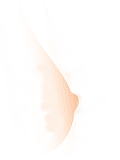
In women, ideal nipple size is around 8mm in diameter, also 8mm in height, of course, these change accordingly to favorites or breast sizes.
In men, about half of women's ideal diameter, which is 4mm is the best, and height , almost flat.
 Enlarged nipples usually resulted from breastfeeding and sometimes
in men breast from natural cause.
Enlarged nipples usually resulted from breastfeeding and sometimes
in men breast from natural cause.

Nipple reduction is done by removing and tucking of skin of the lower base and partially at the lateral side of the upper part of the nipple

30 minutes to an hour is the time needed to perform this procedure which is usually under local anesthesia. Since recovery of wounds at this area is slow, stitch removal is done after 2 weeks. Skin reduction is the main technique of this procedure, so mammary ducts will be preserved and remain intact, meaning breastfeeding is still possible afterwards.
A day of bandage compression is necessary, swelling and bruises might last until 2 weeks.
To avoid bleeding and infection, caution of keeping the area dry for at least 5 days is advisable.
Pricing

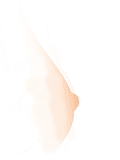 Inverted nipple is a cosmetic concern that can be seen from younger through older women. This issue is caused by underdeveloped mammary ducts which turn out shorter and tend to pull down the nipple.
Inverted nipple is a cosmetic concern that can be seen from younger through older women. This issue is caused by underdeveloped mammary ducts which turn out shorter and tend to pull down the nipple.
Because mostly younger women are eager to repair this problem, it is necessary to obtain consent in possibility of injuring the mammary ducts, meaning the disturbance of the normal breastfeeding. The incision usually goes across the whole diameter of the nipple, but in our clinic, we try our best to preserve the top portion by just cutting the side portion.
Grading of severity:

gradeⅠ nipple flat
protrude easily with stimulating breast push

grade Ⅱ nipple denting or sinking
protrude when pulled with tweezers
grade Ⅲ similar to gradeⅡ, nipple sinking
but not pointing with tweezer pull
requires sutured thread to be pulled
Treatment according to grading:
grade Ⅰ no need of surgery(breast pump or breast feeding as natural remedy)

grade Ⅱ surgery needed. nipple lateral incisions on 2 sides, release duct adhesions,
Z plasty sutures on neck to hold pointed nipple,
1or2 weeks of traction device
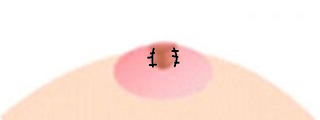
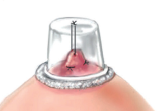
grade Ⅲ surgery needed. nipple incised in half after pulling out with sutures,
release duct adhesion and cut short ones if needed
secure neck with Z plasty stitches, 1or2 weeks of traction device
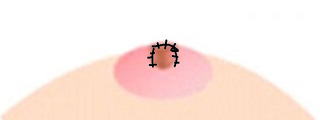
This procedure is usually performed under local anesthesia, swelling and bruises are not that obvious. Requires an hour or more to complete, 1or2 weeks later, stitch and device removal/
Be aware that recurrence might be observed particularly in severe cases. Also cut ducts might not be able to work for breast feeding afterwards.
To avoid unwanted side effects such as infection and have a satisfactory result of the surgery, keep area dry while held by a traction device, by refraining from washing it but just treat it with some aseptic wipes.
Pricing
While fat grafting has many advantages, a list of disadvantages also does exist. Let's see first some of its ADVANTAGES:
・not artificial, self-derived autologous fats are safe
・more natural in shape and touch
・permanently remain in the tissue
・liposuction can be performed together
There might be some more, but these 4 are the main factors in the list.
Next are the DISADVANTAGES:
・most injected fats are resorbed, survival rate as bad as 20% up to 50%
・need treatments to achieve desired volume
・every session needs liposuction procedure
・non-surviving dead fat mass may turn into calcification or infection if not resorbed
About same number of cons as pros is the reality of this method, however, tactics have been developed to cope with these issues. Firstly, injected fats must be rich in fat stem cells(adipose stem cells ASC). Harvested fats is purified to highten ASC's density inside the graft, anticipating stem cells to grow and multiply into mature fat cells inorder to compensate for the resorbed portion of the graft.
Then, actual injection must be done in scattering manner by injecting fats in smaller strips along a layer and the same way at the other levels of the subcutis tissues, fat layers, and muscles, if necessary, to avoid creating a bulk.
Tissue layer condition also affects survival rate of the fats. Specifically, loose spacious layers embrace more of the graft than the dense and firm ones. Body parts with loose layers and saggy excessive skin that has more room usually adopt well to the injected fats about 2 or 3 times of its desired capacity, which is necessary to gain the desired goal. Injecting further more than these might cause low survival rate and undesirable side effects. Only body parts that have extra room for fats can tolerate the adequate enormous graft volume.
Fat graft is purified by the following process:

Liposuction or Mini Lipo by Syringe Method is used for harvesting fats.

Then syringes are centrifuged.

Impurities are separated from purified fats.

Directly inject fats or subdivide them to smaller syringes.
Breast fat transfer is a method that requires certain amount of fats which are usually harvested with the full tummy or thigh liposuction, not mini lipo.


breast fat transfer before/after
downtime: suctioned area swells, get sore, & bruise for 1to2 wks., breast part is puffy, tender, & sometimes bruise a bit for days
Volume of graft transfered is around 200cc on a side, 400cc on both sides. Of course, there might be exemption, but for regular body sizes, around 400cc is a safe amount for breast fat transfer. Fat survival rate really depends on condition of the breast tissue and skin. Loose tissue and excess skin that have plenty of room for fats can see better survival of graft while tighter breast might absorb most of the injected fats.
More than 600cc transfer is often peformed at other facilities, but more is not mostly better. This makes the breast tighter leading to a surrounding where fat graft won't survive that much and sometimes might show unnatural touch from calcification, and , for the worst, infection might occur.
Survival rate of the graft certainly differs in every individual, speaking from long experience, from 20 up to 50%. In American bra sizes, 200cc is a 1-cup upgrade. So 200cc of fats might turn out to be half-cup bigger. More treatments are needed if bigger size is desired. Surviving fats remain permanently.
Pricing
Pricing is only for 1 treatment session.
2nd fat injection and beyond are 50% OFF.
Liposuction fee is required in every session. Refer to Liposuction page for pricing details.
| without tax | with tax | ||
| Fat Transfer | breasts | \200000+full liposuction fee | \220000+full liposuction fee |
2nd fat injection and beyond are 50% OFF.
Liposuction fee is required in every session. Refer to Liposuction page for pricing details.
Hyaluronic Acid Filler Injection for Breast Enlargement
Hyaluronic acid(HA) filler injection does not have the inconvenience usually experienced in fat transfer since it is a ready-to-use injectable, but the substance is absorbed within a year.

breast hyaluronic acid injection before/after
downtime: breast part turns puffy&tender for few days, if rarely bruises occur, takes a week to subside
 hyaluronic acid gel
hyaluronic acid gelAfter a minute of local anesthesia, the filler can be conveniently injected for around 10 minutes. This is the main, or maybe the only, advantage of HA filling, then the following disadvantages might follow:
・can be absorbed and excreted from body 100%
・expensive since it's an artificially-synthesized product
・even soft gel might turn out hard when injected in mass
・extensive injection of the gel might produce some permanent uncertain lumps
For such reasons, HA filler injection is better limited from 30㏄ to see effect, up to 100cc, which might be the upper limit to avoid unwanted efffects.
Pricing
| with tax | without tax | ||
| Hyaluronic Acid Breast Enlargement | 10㏄ | \60000 | \66000 |
Breast Lift(Mastopexy)/ Reduction
Mastopexy or breast lift is done for saggy breast, and breast tissue reduction is performed simultaneously if smaller size is desired or breast implant insertion if fuller breast is the goal. The skin on the lower part of the breast will be removed and tucked, and the areola will be transfered to a higher skin level around 20cm from sternal notch.
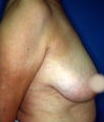
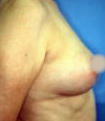
breast lift before/after
downtime: swelling&pain last for 1to2 wks.,
bruises take 2to3 wks. to subside
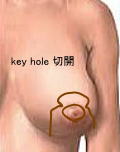
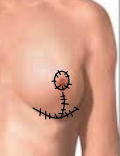
Incision is made around areolar rim, down vertically to mammary fold inorder to remove excess skin, shaping a surgical wound that resembles a 'key hole', the reason why it is called the key-hole incision. Wound blends to skin color in time. If areolar sagging is not that severe, breast enlargement with implants only might work to see fuller lifted breast.
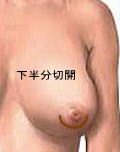
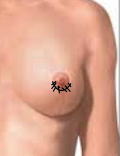
If breast reduction only is the goal, incision of areola's lower half rim is big enough already to remove breast tissues.
This procedure is performed under general anesthesia, requires physical and lab tests preoperatively.
It takes 3 hours or more to complete this surgery, a week of bandage compression and months of band pressing follows. Stitch removal is 2 weeks later.
Breast wounds are lengthy , so they take time on checking up, taking measures to avoid infection and splitting.
Breast lift has to resist the pulling force of gravity that tends to spread scar's width. Taping of the wound is recommended to avoid this.
Pricing
General Anesthesia Fee \50000(with tax \55000)


breast lift before/after
downtime: swelling&pain last for 1to2 wks.,
bruises take 2to3 wks. to subside


Incision is made around areolar rim, down vertically to mammary fold inorder to remove excess skin, shaping a surgical wound that resembles a 'key hole', the reason why it is called the key-hole incision. Wound blends to skin color in time. If areolar sagging is not that severe, breast enlargement with implants only might work to see fuller lifted breast.


If breast reduction only is the goal, incision of areola's lower half rim is big enough already to remove breast tissues.
This procedure is performed under general anesthesia, requires physical and lab tests preoperatively.
It takes 3 hours or more to complete this surgery, a week of bandage compression and months of band pressing follows. Stitch removal is 2 weeks later.
Breast wounds are lengthy , so they take time on checking up, taking measures to avoid infection and splitting.
Breast lift has to resist the pulling force of gravity that tends to spread scar's width. Taping of the wound is recommended to avoid this.
Pricing
| without tax | with tax | ||
| Breast Lift | both breasts | \500000 | \550000 |
| +silicone implants | +\300000 | +\330000 | |
| Breast Reduction | both breasts | \400000 | \440000 |
Gynecomastia Correction
Enlarged male breast tissue(gynecomastia)is the main concern of men in
breast care especially in younger generation. Male hormone testosterone
usually acts to develop a masculine chest contour. But when it does not
work well, minute amount of female hormone in male body becomes a dominant
trigger to create a feminine breast shape.


gynecomastia gradeⅡa correction before/after
downtime: swelling&pain for 1to2 wks.,
bruises might be observed for 2to3 wks.
Famous grading of gynecomastia' s severity goes as follows:
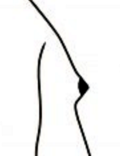
gradeⅠ hypertrophic tissue just under areola
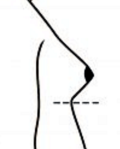
grade Ⅱa hypertrophy extends all over breast
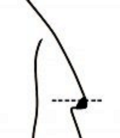
grade Ⅱb severe hypertrophy with saggy skin but nipple stays higher than fold
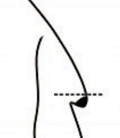
grade Ⅲ severe hypertrophy with saggy skin, nipple lower than fold
Treatment with surgery is done accordingly to grading:
grade Ⅰ incision along areolar lower half rim, only removal of breast tissue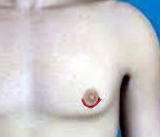
grade Ⅱa same incision as gradeⅠ, removal of breast tissue,
together with minilipo of breast from outer approach
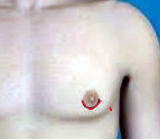
grade Ⅱb same remedy as grade Ⅱa
grade Ⅲ breast lift with 'key-hole' incision(refer to breast lift mentioned above)
transfer of areola to higher skin level
removal of breast tissue, excess skin, & mini lipo
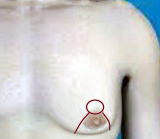
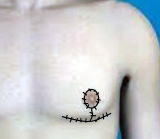
Grade Ⅰup to grade Ⅱb cab be performed under local anesthesia while grade Ⅲ needs general anesthesia. A week of bandage compression, then stitch removal 2 weeks later. Swelling and bruises last around 2 or maybe 3 weeks.
To avoid bleeding and infection, caution of keeping wound dry for a week mst be observed.
Pricing
General Anesthesia \50000 (with tax \55000)


gynecomastia gradeⅡa correction before/after
downtime: swelling&pain for 1to2 wks.,
bruises might be observed for 2to3 wks.
Famous grading of gynecomastia' s severity goes as follows:

gradeⅠ hypertrophic tissue just under areola

grade Ⅱa hypertrophy extends all over breast

grade Ⅱb severe hypertrophy with saggy skin but nipple stays higher than fold

grade Ⅲ severe hypertrophy with saggy skin, nipple lower than fold
Treatment with surgery is done accordingly to grading:
grade Ⅰ incision along areolar lower half rim, only removal of breast tissue

grade Ⅱa same incision as gradeⅠ, removal of breast tissue,
together with minilipo of breast from outer approach

grade Ⅱb same remedy as grade Ⅱa
grade Ⅲ breast lift with 'key-hole' incision(refer to breast lift mentioned above)
transfer of areola to higher skin level
removal of breast tissue, excess skin, & mini lipo


Grade Ⅰup to grade Ⅱb cab be performed under local anesthesia while grade Ⅲ needs general anesthesia. A week of bandage compression, then stitch removal 2 weeks later. Swelling and bruises last around 2 or maybe 3 weeks.
To avoid bleeding and infection, caution of keeping wound dry for a week mst be observed.
Pricing
| without tax | with tax | ||
| Gynecomastia Correction | grade Ⅰboth breasts | \180000 | \198000 |
| grade Ⅱab both breasts | \300000 | \330000 | |
| grade Ⅲ both breasts | \500000 | \550000 |
Areola Reduction
Ideal areola size may vary in different breast sizes, but usually said
to be around 3.5 cm in diameter. Reduction is designed to achieve this goal but areolas on
bigger breasts tend to stretch out easily months later, resulting in a
little more extended sizes than planned. So it is easier to create smaller
areolas in smaller breasts than the bigger ones which are easily affected
by the gravity.
Areola reduction is done by removing the outer excess area and tucking the skin together creating a circular wound around the rim. By making the scar at the boundary, it will not be easily recognized when the scar heals with lighter color than the skin afterwards.
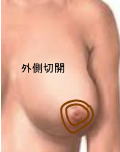
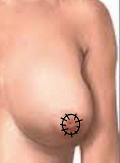
Treatment can be done usually under local anesthesia, needs an hour to complete. A day of compression with gauze and band is needed, then stitch removal a week later. Swelling and bruises might last around 2 weeks.
To avoid bleeding and infection postsurgically, caution of keeping wounds dry for at least 5 days is advisable.
Pricing
Areola reduction is done by removing the outer excess area and tucking the skin together creating a circular wound around the rim. By making the scar at the boundary, it will not be easily recognized when the scar heals with lighter color than the skin afterwards.


Treatment can be done usually under local anesthesia, needs an hour to complete. A day of compression with gauze and band is needed, then stitch removal a week later. Swelling and bruises might last around 2 weeks.
To avoid bleeding and infection postsurgically, caution of keeping wounds dry for at least 5 days is advisable.
Pricing
| with tax | without tax | ||
| Areola Reduction | both sides | \150000 | \165000 |
Nipple Reduction


In women, ideal nipple size is around 8mm in diameter, also 8mm in height, of course, these change accordingly to favorites or breast sizes.
In men, about half of women's ideal diameter, which is 4mm is the best, and height , almost flat.
 Enlarged nipples usually resulted from breastfeeding and sometimes
in men breast from natural cause.
Enlarged nipples usually resulted from breastfeeding and sometimes
in men breast from natural cause. 
Nipple reduction is done by removing and tucking of skin of the lower base and partially at the lateral side of the upper part of the nipple

30 minutes to an hour is the time needed to perform this procedure which is usually under local anesthesia. Since recovery of wounds at this area is slow, stitch removal is done after 2 weeks. Skin reduction is the main technique of this procedure, so mammary ducts will be preserved and remain intact, meaning breastfeeding is still possible afterwards.
A day of bandage compression is necessary, swelling and bruises might last until 2 weeks.
To avoid bleeding and infection, caution of keeping the area dry for at least 5 days is advisable.
Pricing
| without tax | with tax | ||
| Nipple Reduction | both sides | \150000 | \165000 |
Inverted Nipple Correction

 Inverted nipple is a cosmetic concern that can be seen from younger through older women. This issue is caused by underdeveloped mammary ducts which turn out shorter and tend to pull down the nipple.
Inverted nipple is a cosmetic concern that can be seen from younger through older women. This issue is caused by underdeveloped mammary ducts which turn out shorter and tend to pull down the nipple. Because mostly younger women are eager to repair this problem, it is necessary to obtain consent in possibility of injuring the mammary ducts, meaning the disturbance of the normal breastfeeding. The incision usually goes across the whole diameter of the nipple, but in our clinic, we try our best to preserve the top portion by just cutting the side portion.
Grading of severity:

gradeⅠ nipple flat
protrude easily with stimulating breast push

grade Ⅱ nipple denting or sinking
protrude when pulled with tweezers
grade Ⅲ similar to gradeⅡ, nipple sinking
but not pointing with tweezer pull
requires sutured thread to be pulled
Treatment according to grading:
grade Ⅰ no need of surgery(breast pump or breast feeding as natural remedy)

grade Ⅱ surgery needed. nipple lateral incisions on 2 sides, release duct adhesions,
Z plasty sutures on neck to hold pointed nipple,
1or2 weeks of traction device


grade Ⅲ surgery needed. nipple incised in half after pulling out with sutures,
release duct adhesion and cut short ones if needed
secure neck with Z plasty stitches, 1or2 weeks of traction device

This procedure is usually performed under local anesthesia, swelling and bruises are not that obvious. Requires an hour or more to complete, 1or2 weeks later, stitch and device removal/
Be aware that recurrence might be observed particularly in severe cases. Also cut ducts might not be able to work for breast feeding afterwards.
To avoid unwanted side effects such as infection and have a satisfactory result of the surgery, keep area dry while held by a traction device, by refraining from washing it but just treat it with some aseptic wipes.
Pricing
| without tax | with tax | ||
| Inverted Nipple Correction | both sides | \160000 | \176000 |
Miyagi Cosmetic Surgery宮城美容外科クリニック
〒900-0016
沖縄県那覇市前島2-2-1(3F)
2-2-1-3F Maejima, Naha City
Okinawa, Japan 900-0016
TEL 098-860-9120
FAX 098-860-9176
※電話が混み合っている場合、ウェブやメールでの予約も受けております。オンライン予約はこちら
In case line is busy, please make reservations through our website or e-mail.
For online booking click here
e-mail miyagics@woody.ocn.ne.jp